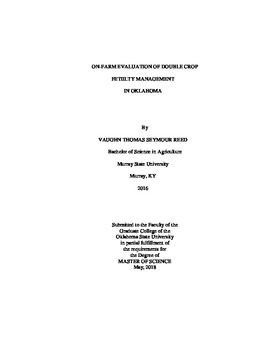| dc.description.abstract | Many producers in Oklahoma choose to plant summer crops following the harvest of winter crops to increase farm revenue. Often this practice is done while limiting costly inputs to reduce economic risk. This study aims to determine whether there is potential for producers to increase yields of double crops with the addition of fertilizer. Also, the study will evaluate soil test as a way to predict nutrient response. Nutrient rich strips of nitrogen (N), phosphorus (P), potassium (K), and sulfur (S) were applied at 61 sites across Oklahoma in 2016 and 2017, on three different double crops (soybean, grain sorghum, sunflower), with varying environmental conditions. Nutrient rich strips were applied at a rate of 257.6 kg ha-1 of product to a 1.8 by 45.7 meter strip each. Urea (46-0-0), triple super phosphate (0-45-0), potash (0-0-60), and gypsum (0-0-0-19) were used for sources N, P, K, and S, respectively. Composite surface (0-15 cm) and subsurface (15-45cm) soil samples were taken prior to application of the strips for soil nutrient analysis. At maturity, four- one m2 subplots were hand harvested from each strip, as well as four one m2 subplots from the producer practice outside of the plot. Of 61 locations and 244 comparisons, 20 positive responses were recorded on 14 sites. Of these responses, one was a response to N, five were a response to P, ten were responses to K, and there were four responses to S. Seventeen responses were on soybean sites (0 N, 5 P, 9 K, 3 S), three were on grain sorghum sites (1 N, 0 P, 1 K, 1 S), and zero sunflower sites that were responsive. This study documented that the produces nutrient management strategies maximized yields in 77% of the fields evaluated. This high value indicates that Oklahoma double crop producers are adequately managing the nutrient inputs. Yet as there were 23% of the fields that responded to addition fertility there is still room to be gained. This project suggests that further work is needed to provide producers with a more reliable measure of when fertilizer is needed. | |
